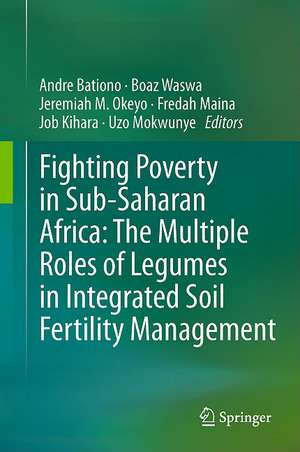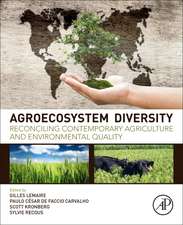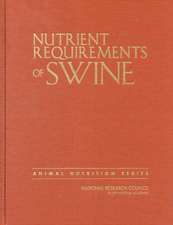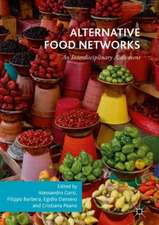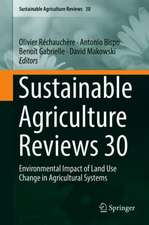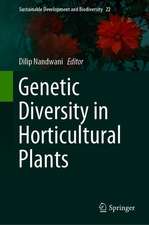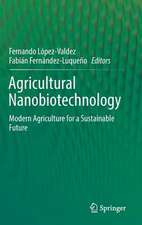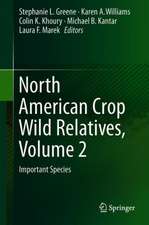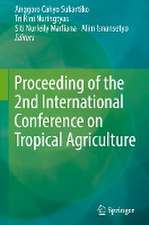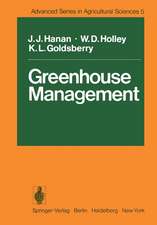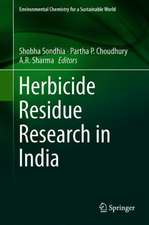Fighting Poverty in Sub-Saharan Africa: The Multiple Roles of Legumes in Integrated Soil Fertility Management
Editat de Andre Bationo, Boaz Waswa, Jeremiah M. Okeyo, Fredah Maina, Job Kihara, Uzo Mokwunyeen Limba Engleză Hardback – 24 aug 2011
| Toate formatele și edițiile | Preț | Express |
|---|---|---|
| Paperback (1) | 781.35 lei 38-45 zile | |
| SPRINGER NETHERLANDS – 16 oct 2014 | 781.35 lei 38-45 zile | |
| Hardback (1) | 930.59 lei 6-8 săpt. | |
| SPRINGER NETHERLANDS – 24 aug 2011 | 930.59 lei 6-8 săpt. |
Preț: 930.59 lei
Preț vechi: 1134.87 lei
-18% Nou
Puncte Express: 1396
Preț estimativ în valută:
178.18€ • 185.54$ • 147.83£
178.18€ • 185.54$ • 147.83£
Carte tipărită la comandă
Livrare economică 14-28 februarie
Preluare comenzi: 021 569.72.76
Specificații
ISBN-13: 9789400715356
ISBN-10: 9400715358
Pagini: 360
Ilustrații: VIII, 246 p.
Dimensiuni: 155 x 235 x 23 mm
Greutate: 0.48 kg
Ediția:2011
Editura: SPRINGER NETHERLANDS
Colecția Springer
Locul publicării:Dordrecht, Netherlands
ISBN-10: 9400715358
Pagini: 360
Ilustrații: VIII, 246 p.
Dimensiuni: 155 x 235 x 23 mm
Greutate: 0.48 kg
Ediția:2011
Editura: SPRINGER NETHERLANDS
Colecția Springer
Locul publicării:Dordrecht, Netherlands
Public țintă
ResearchCuprins
Preface.- Chapter 1: Agro-ecological distribution of legumes in farming systems and identification of biophysical niches for legumes growth, Nandwa SM (The late), Obanyi SN and Mafongoya PL.- Chapter 2: Socio- economic contribution of Legumes to Livelihoods in Sub-Saharan Africa; Odendo M, Bationo A and Kimani S.- Chapter 3: Inter And Intra-Specific Variation Of Legumes And Mechanisms To Access And Adapt To Less Available Soil Phosphorus And Rock Phosphate, Nandwa SM (The late), Bationo A, Obanyi SN, Rao IM, Sanginga N and Vanlauwe B.- Chapter 4: Legume based cropping systems and soil biodiversity dynamics; Karanja NK, Kimenju JM, Esilaba AO, Jefwa J and Ayuke F.- Chapter 5: Strategies to adapt, disseminate and scale out legume based technologies; Mugendi DN, Waswa BS, Mucheru MW and Kimetu JM.- Chapter 6: Comparative Analysis of the Current and Potential Role of Legumes in Integrated Soil Fertility Management in West and Central Africa; Bationo A, Kimetu J, Vanlauwe B, Bagayoko M, Koala S and Mokwunye AU.- Chapter 7: Comparative Analysis of the Current and Potential Role of Legumes in Integrated Soil Fertility Management in East Africa; Mugendi DN, Waswa BS, Mucheru M, Kimetu JM and Palm C.- Chapter 8: Comparative Analysis of the Current and Potential Role of Legumes in Integrated Soil Fertility Management in Southern Africa; Mapfumo P.- Chapter 9: Options for improving plant nutrition to increase common bean productivity in Africa; Jansa J, Bationo A, Frossard E and Rao IM.- Conclusion and the way forward.
Textul de pe ultima copertă
Inclusion of legumes in cropping systems can play an increasingly important role to maintain soil fertility and sustain crop production. Legumes are an important source of nutrition to both humans and livestock by providing the much needed protein, minerals, fiber and vitamins. The sale of legumes seed, leaves and fiber generates income for the marginalized communities especially women in the dryland areas. Cultivation of legumes is essential for the regeneration of nutrient-deficient soils. Legumes can be incorporated into cropping systems as green manure, intercropped or rotated with cereals and as leguminous shrubs in improved fallow systems. By biologically fixing nitrogen (BNF) in the soil, legumes provide a relatively low-cost method of replacing otherwise expensive inorganic nitrogen in the soil. Legumes also improve other soil physical properties, provide ground cover and reduce soil erosion, increase soil organic matter, cation exchange capacity, microbial activity and lowers soil temperature and suppress weeds and pests. All these beneficial effects result in enhanced soil fertility and boosts subsequent cereal crop yields. Legumes therefore play an important role of improving the livelihoods of smallholder farmers around the world.
Despite the above benefits, production of legumes in SSA is hampered by a number of constraints. Most soils in SSA are deficient in key nutrients especially phosphorus that is essential for proper legume establishment. Other limitations include low soil pH, high salinity, drought and flooding. Legume production is also hindered by new diseases, pests, and weeds, which farmers need to learn how to control if the full benefits of legumes are to be gained. Beyond the abiotic factors are issues of access to inputs (improved seed and fertilizers), markets and access to relevant production information. This book presents a synthesis of research work on legumes and draws attention to the importance of legumes inintegrated soil fertility management (ISFM) and poverty alleviation in SSA.
Despite the above benefits, production of legumes in SSA is hampered by a number of constraints. Most soils in SSA are deficient in key nutrients especially phosphorus that is essential for proper legume establishment. Other limitations include low soil pH, high salinity, drought and flooding. Legume production is also hindered by new diseases, pests, and weeds, which farmers need to learn how to control if the full benefits of legumes are to be gained. Beyond the abiotic factors are issues of access to inputs (improved seed and fertilizers), markets and access to relevant production information. This book presents a synthesis of research work on legumes and draws attention to the importance of legumes inintegrated soil fertility management (ISFM) and poverty alleviation in SSA.
Caracteristici
A comprehensive review of research experiences on legumes in sub Saharan Africa Presents a regional perspective of legume production systems for sub Saharan Africa Contribution from a multi-disciplinary team of experts
